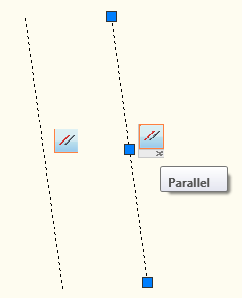This is a new feature in AutoCAD 2010.
Parametric constraints allow you to force an object to behave the way you want it to. If you need a line to remain vertical at all times, you can set a constraint on it to do just that. Need 2 circles to remain the same diameter? How about a circle for a bolt that must stay 1/2" diameter? No problem with constraints. These are just some examples that will make it easier to control your drawing.
Constraints can be divided into two groups and are on the Parametric Tool Panel:
Geometric Constraints |
 |
Constrains a object based on geometric properties : vertical, horizontal, etc |
Dimensional Constraints |
 |
Constrains an object based on a set length or radius. |
This tutorial is not going to explain each one, but jut show you how they're used and then you can explore the others and learn how they work. This may not be something that you use in everyday drafting, but it can very useful at times.
Geometric Constraints
Let's start with an easy one. Draw 2 random lines without having Ortho on.
Click on the Parallel Constraint icon  and then select one line and then the other. The second line should now be parallel with the first. and then select one line and then the other. The second line should now be parallel with the first.
Command: _GeomConstraint
Enter constraint type
[Horizontal/Vertical/Perpendicular/PArallel/Tangent/SMooth/Coincident/CONcentric
/COLlinear/Symmetric/Equal/Fix] <Symmetric>:_Parallel
Select first object: <Select first line>
Select second object: <Select second line>
The angle of the first line will be the constraint put upon the second line. Now if you try moving one of the lines around, you'll find that the two will stay parallel. If you highlight one, the other becomes highlighted. You also now have constraint indicators next to the objects.

Most of the geometric Constraints work the same way. Select an object to create the constraint and then select another to match. You can only constrain 2 objects at a time, but you can use multiple constraints to constrain multiple objects. If you copy one of the constrained objects, the constraint does not copy with it.
Try out a bunch of the geometric constraints before moving on to dimensional constraints. Notice how the procedure is pretty much the same. See what happens when you add a new constraint to an object that already has a constraint.
Dimensional Constraints
Dimensional constraints are different from what you just worked with. Instead of making a line vertical (for example), you can make a line 10 units long and make it stay that way until you change it. You can more than one dimensional constraint on certain objects.
Draw a random angled line on the screen. Pick on the Aligned constraint icon.  Pick two points on the line. Pick two points on the line.
Notice that even if you have your Osnaps off, you can only pick the endpoints and midpoint on the line. After selecting the 2 points, you can now enter a length that you want the distance between those points to be.

With the constraint still highlighted, enter a number. d3 in this example refers to the 3rd dimensional constraint in the drawing. If you added a constraint from end to middle, add another from end to end (or vice versa). Notice that the constraint will be double the first one. If you change one, the other will change.
Mixing it up
You'll notice in the geometric constraints panel, there is one for equal. this can used to make objects the same size. In this example, draw 2 different sized circles. Make one a dimensional constraint for diameter. now use the Equals constraint  to make the other one the same. to make the other one the same.
Imagine using this when you are designing a part with holes to be drilled. If the part isn't finalized yet, the hole size might change. Using the Equals constraint would allow to change one and make the others the equal at the same time.
This tutorial has shown you the basics of working with parametric constraints. The are simple to use, easy to delete if you don't need them any more, and they can be a great time saver. Practice with them. Go over some previous exercises using constraints.
|